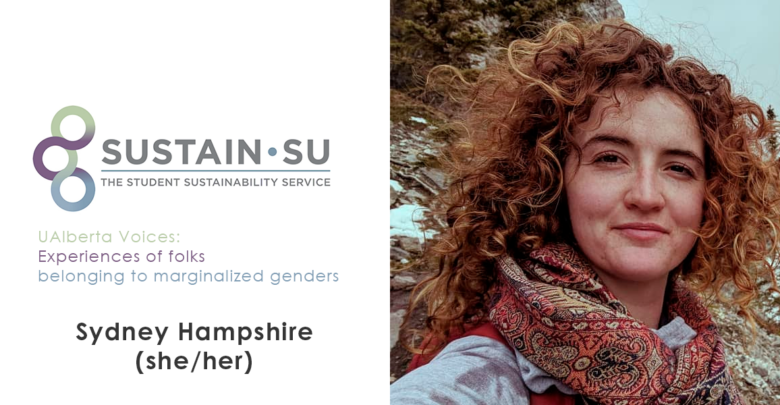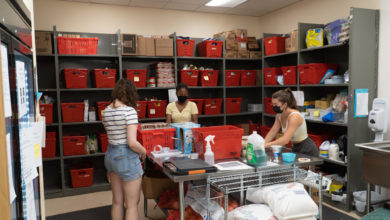Creating accessible spaces on campus and within the community: a Q&A with Sydney Hampshire
 Pia Co
Pia CoThis guest column is written through a partnership with Sustain SU, a service provided by the University of Alberta Students’ Union. The interviews and articles have been conducted and written by Sustain SU ambassadors, and edited by The Gateway for publication.
This article is the fourth of a multi-part series named “UAlberta Voices: Experiences of Folks Belonging to Marginalized Genders“ that aims to highlight the experiences of students and community members belonging to marginalized genders in leadership positions within the University of Alberta campus and Edmonton community.
This is a question and answer (Q&A) session with Sydney Hampshire (she/her). Sydney is a woman with disabilities and a U of A graduate that is working to make spaces more accessible for people with limited physical mobility.
This interview has been edited for brevity and clarity.
Q: Could you please tell us about yourself and about Click&Push Accessibility?
Sydney Hampshire [she/her]: My name is Sydney Hampshire. I grew up in a rural community of about 300 people outside of Grande Prairie called La Glace. It was very small and that comes with positives and negatives. It was good because it was such a small tight-knit community and I liked growing up somewhere I could go outside all the time. However, it was hard because I had a stroke when I was nine years old so I had complete paralysis of my left side. Things are a lot better now. I can now talk so it is not as bad as it was. When it happened, I could not speak, walk or use my left hand and that was hard because I was dominantly left-handed. I couldn’t do something as simple as washing my hands or going to the bathroom. [When it comes to] those things, everyone thinks, “oh it’s so easy” — but I couldn’t get my right hand to do it. So growing up in a small community where there weren’t a lot of rehabilitation facilities and it was on you to do the physiotherapy that you needed to get better was a big challenge, and is still a big challenge for people in those small communities.
I went to the University of Alberta, where I just finished a master’s degree at the faculty of rehabilitation medicine in 2020. That’s how I got involved with Click&Push. Click&Push is a software and hardware company that looks to create more accessible spaces for people, specifically with mobility impairments right now but it’s all about access, that’s the main goal of our company: to make spaces more accessible.
We started out with our hardware. We have a device that is similar to a Fitbit for your wheelchair and an app that helps people navigate their spaces by allowing them to mark barriers on their path. The app called The Atlas is kind of like Google Maps for wheelchair users. It doesn’t just say “the road is clear”, it says “there’s a pothole here”. Or, “there’s no curb cut” or “the elevators are out of power” or “the door doesn’t work” or “this accessible washroom isn’t really great”. The app does this in a crowdsourced way. Manual wheelchair users, able-bodied individuals, or anybody who is around and perceives a barrier can report it so wheelchair users use it to plan their routes. A good example of how the app can be used on-campus is… let’s say I’m a first-year student in a wheel-chair, and on top of being lost on campus but I also don’t know where I’m supposed to sit in a classroom because I don’t know where the accessible desk is. Our goal is to help make spaces more accessible on campus and in the broader Edmonton and Alberta community.
Q: What is your role in Click&Push Accessibility?
Hampshire: On paper, I am the Chief Operating Officer and also a founding shareholder in the company, so I’ve been with this company since the beginning. I think it is cool because business is the last thing I’d imagine I’d be doing when I joined my undergrad but now here I am today! However, my job is not only limited to certain duties. Click&Push is a start-up, therefore everyone in our team has to put in the effort and combine our skills for the benefit of our team. We all also have to step up and learn something if the team needs it. For example, I find myself doing a lot of business operations for the company, strategy sessions, as well as networking with the community and stakeholders across Alberta and British Columbia.
Q: How did the Click&Push app begin? Where did the idea come from?
Hampshire: Click&Push Accessibility was founded out of the rehabilitation robotics lab at the University of Alberta. I encountered this lab while doing my masters. This lab looks at manual wheelchair propulsion and how manual wheelchair users push themselves, specifically in racing wheelchairs. It’s very cool because the lab has a virtual reality simulator, so we studied the differences in propulsion in the real world and in the virtual world for athletes. This all led us to develop equipment that measures the movement of wheelchair users in the real world.
We created this device called “Red-Liner” which is like a Fitbit for wheelchair users that we now call “Saggita”. This device needed an app to read and monitor the data so then all of this then [resulted] into Click&Push. We then saw that people might not want the device and just want the app to track where they are going. The original concept changed a lot to where we are now, but our mission has always been to help wheelchair users. We want to get lab technology into the hands of everyday people to help them navigate their day.
Q: As an individual with a disability, are there specific challenges you have encountered in your start-up journey because of your gender and/or your disability?
Hampshire: If anything, I would always hope that the characteristics that make me me, you know being a disabled individual and being a woman, would help because they are different, and diversity is good. I am a very positive and optimistic person, but I would be amiss to not say that there are tons of challenges that people with disabilities face every single day.
I feel lucky that many of my challenges I can deal with and so I feel that they are minimal but there’s still there. Even though it doesn’t feel really like there’s effort, still at every single moment there’s resilience in what you’re doing as a disabled person. It is part of my life and I choose to see it that way.
In a way, my gender is also like that. That’s how I see all of these characteristics that make us who we are and this identity. It is always something that’s going to be there, but I always choose to see it as a strength because it’s my voice at the end of the day and how do I see it and how do I use it to make me me and make me a better person and change the world. It’s always there but it helps. I choose to see it as something that helps, and I think that Click&Push is lucky to have me because I do bring a disabled voice to our meetings. I do bring a gender voice to our meetings and I am OK with that because I am ok with who I am, I choose to see my gender and my disability in a good light.
Q: What is something you wish people would be more conscious of when talking about creating inclusive spaces, especially in terms of including people with mobility impairments and other disabilities?
Hampshire: This is a really cool question. The thing I would want more people to consider is the fact that these inclusive spaces are built for everyone. It’s a simple concept but it means that the space is universally designed; it is built in a way that allows everyone to be a part of it and everyone to access it. I would really just push people to take heart in the fact that this means that this space is built for you, for them and for everyone no matter where you’re from, who you are, or what your ability level is. I hope that the reader just really thinks about that and smiles because it’s important. I hope it pushes them to take this vision forward and be a part of our work. An inclusive space can mean many things, but I just want people to identify with the fact that it’s for everyone.
Q: Why is having accessible and inclusive spaces so important for mental health?
Hampshire: I think we see this a lot right now. Because of the pandemic, everyone is confined to [be at] home so I think that probably everyone in their home environment has changed something about it since they’ve started working from home. If there was something that they didn’t like about their home they definitely haven’t kept it that way for the past year, they’ve changed it. I think that shows us how important a well-built space is.
Additionally, I see a lot about how the pandemic has a huge effect on mental health [due to people] being isolated. I would argue that people with mobility impairments are probably not going out as much because it’s more difficult. Whether that be because taking the bus is more difficult, or they’re worried about their safety and sanitation. Lots of people with mobility impairments might have secondary complications so they’re worried about their health especially right now, so they’re more isolated and lonelier. Disability, mobility impairments, and even mental health issues in general push people to stay at home and stay isolated and so that’s worse for your mental health. I think it’s really unacceptable for manual wheelchair users specifically to be isolated in the winter because spaces are inaccessible including campus. I know many people actually who are para-athletes and have left Alberta to go to British Columbia to train because it’s better there since it’s not as hard for them to get around. I think that’s sad just because what if sports is what was really helping their mental health and then they can’t do that here? What if they can’t move to British Columbia? Having accessible spaces really matters when it comes to mental health.
Q: In the recent years, do you perceive we have been moving towards a more inclusive and accessible future for people with mobility impairments and other disabilities? In what aspects can improve as a community?
Hampshire: I really want to say yes because I am a super optimistic person, and I believe in the work that we’re doing and I believe in the work that so many like people have done for so long. Whether that be as researchers or as community advocates or as people with disabilities who pushed for change. I am very grateful for the things that have been done but I just there’s just so much that more that needs to be done and there are tangible things that actually need to be done to help people day-to-day with disabilities.
I have a few things in mind, for example, the other day I came across this Washington Post article about how smart wheelchairs are being built. I think that’s great but why is that just happening now? People should not be asked to push around with the strength of their arms right because the muscles on the arms are not meant to be walked on. [There are] people who are manual wheelchairs users that end up, in 10 years or less, with stress on their shoulders that cause pain. They [then] need a power chair, or surgery, so their whole life is changed again and their quality of life may go down because they can’t do the things that they used to do. This Washington Post article also touches on this idea that manual wheelchairs should be sleek, small and be an extension of somebody’s style and personality — because that’s what they already are. People in manual wheelchairs see their wheelchairs as an extension of themselves but the wheelchairs should also be helping them. So maybe [the wheelchair] is much lighter, it’s designed in a better way for them, and maybe it has some built-ins that allow them to put less power in because the wheelchair is also putting power. We want to design better wheelchairs so that somebody can get the look that they want, get the function that they need, and be eligible for funding to get it.
I also want to address the barriers that get in the way of people who are trying to rehabilitate in the community after they get discharged. Rehabilitation in the community is really how people get better or meet the goal that they want. Right now, there’s barriers to that because people don’t have the technology, the devices, have the knowledge, or the access to physiotherapy. For example, let’s say for me to get better I need some equipment and I need some knowledge about what exercises I should do. The transition to the community needs to be more seamless and more directed and tailored to people. I personally do think there are advances being made so I hope we will keep pushing for that, but I do think that there needs to be more emphasis on rehabilitation and maybe even specific grants and funding for rehabilitation because the hospital can only do so much. The real thing that makes people get better is their own drive which happens when they get home.
I really would like to see more grants going to the rehabilitation side [of treatment], just to see what that would do. I do think that there are a lot of people that try to help in this realm, which is good, but the approach to rehab must be biopsychosocial and it has to be holistic. Everyone has to consider a more complete approach to rehabilitation, whether they be a doctor, an occupational therapist, a rehabilitation scientist, or an engineer.
Q: What is next for Click&Push Accessibility? Any new exciting things?
Hampshire: We are currently working hard with the University of Alberta Libraries to map their spaces for our app. The library at the university has been very progressive and open to the idea to make campus spaces more accessible. We are hoping to do this in partnership with another organization that is more experienced in indoor spaces while we are more skilled in mapping outdoor spaces. In line with that, we are hoping to get more manual wheelchair users in the community to use The Atlas. In terms of hardware, we are in talks with a few wheelchair companies to try and get them to integrate Sagitta into their wheelchairs so they can be wheelchairs with their own integrated Fitbit. Another cool thing we are doing is we are conducting a study in partnership with another wheelchair manufacturer to see how their wheelchairs perform differently in the summer versus in the winter. We are trying to be very creative with ways to get the idea to stick and try to get people to care about this. Ultimately, we want the research that goes on at the University of Alberta to reach the hands of the community and to improve the lives of members of our community.
Q: Where can people get in contact with Click&Push Accessibility if they are interested in more information?
Hampshire: My team and I can be contacted at [email protected]. Any interest in Click&Push is super appreciated whether you just want to chat or join the team as a volunteer or work for us, we are happy to hear from you. Regardless of background education whether it’s business, engineering, research, or anything else, you can reach out and we will try and find a spot for you.
Sustain SU Ambassador’s Note:
Addressing the United Nations’ Sustainable Development Goals #3, #5 & #11: Good health and well-being, gender equality and reduced inequalities
There is a growing need for safe, inclusive, and accessible spaces within our campus and in our community for those who belong to vulnerable, and marginalized communities, such as persons with disabilities. While our community has progressed in developing accessible spaces for all members of our community, there is still room to improve. As citizens, we must strive to support and promote small-businesses like Click&Push, who work towards delivering accessible spaces for all individuals. Raising awareness, and educating ourselves about inclusive spaces, accessibility, and mobility systems is of utmost importance. Doing so will not only aid in improving the quality of life and wellbeing of individuals who have less access to our city’s welfare programs and transportation systems, but will also help sustain an inclusive ideology for generations to come.
This guest column is written by Sustain SU volunteers through a partnership with Sustain SU, a service provided by the University of Alberta Students’ Union. To learn more about Sustain SU or to get involved, visit their website.




